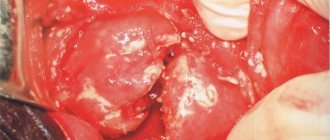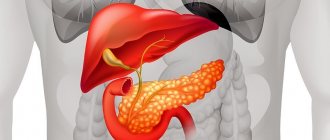Many people are interested in what it is—pancreatic fibrosis—and how exactly the disease progresses. The changes occurring in this organ are considered a very complex process of degeneration of healthy tissue.
The result of the disease is the gradual replacement of normal cells with connective tissue. It is important to promptly determine the course of the problem and carry out treatment to prevent the development of dangerous complications.
Features of the disease
Those who have been diagnosed with this disease need to know what it is - pancreatic fibrosis - and exactly how it manifests itself. This organ consists of tissues of different structures, such as stroma and parenchyma. The stroma represents a kind of frame that performs a supporting function. Parenchyma is a collection of cells that produce hormones and pancreatic juice. Exposure to unfavorable factors leads to inflammation and cell death.
Dead areas are replaced with connective tissue. If scar tissue forms in place of the glandular tissue, this indicates the occurrence of fibrosis. The problem is that the organ can no longer produce enzymes and hormones normally, which significantly reduces its functionality. This is an irreversible process, since it is simply impossible to restore dead glandular tissue. In some cases, it is very difficult to control, which leads to the development of a tumor.
What is fibrosis and fibrolipomatosis of the pancreas?
The replacement of normally functioning pancreatic cells with connective tissue (fibrosis) or simultaneously with the formation of fat cells (fibrolipomatosis) is not an independent disease. This is an objective sign of pathological processes occurring in the tissues of the pancreas. Without special examination methods, these changes cannot be detected. They are detected during an ultrasound examination of the digestive organs.
general information
The pancreas is the most vulnerable organ of the gastrointestinal tract. This is due to its anatomy and physiology. It is exposed to many factors that can lead to the development of inflammatory processes, neoplasms (benign and malignant), calculi, tissue necrosis, and metabolic diseases.
Chronic processes that have a sluggish course lead to structural changes: pancreatic cells die, their place is taken by connective tissue or fat, often all types of tissues unusual for the organ are present. Fluid formations may simultaneously occur, and then cystic fibrosis of the pancreas develops.
These changes in the parenchyma develop gradually, over a long period, and can occur unnoticed by humans due to the absence of clear clinical manifestations. In many cases, they can be detected when the changes have become irreversible and have occupied a significant part of the parenchyma. Fibrosis, lipomatosis or fibrolipomatosis are similar in their development, clinical manifestations in later stages and can sometimes be present simultaneously.
Lipofibromatosis is a fatty degeneration of the pancreas in which connective tissue is unevenly distributed between fat cells. Most often, it is observed in older people who have suffered from diabetes for a long time, and develops due to impaired metabolism (diabetes) or against the background of long-term inflammatory processes.
With intensive local growth of connective tissue, nodes are formed - fibromas, which are sometimes discovered by chance, as an ultrasound finding.
Similar changes in the pancreatic parenchyma develop with long-term pancreatitis and go through 3 stages (according to the volume of altered pancreatic tissue):
- 1 - 1/3 of the organ is affected;
- 2 - up to 60% of the pancreas tissue is changed;
- 3 - more than 60% of normal tissue is lost.
Tissue transformation can be:
- local - occupy a small area of the gland;
- diffuse - uniformly affect the entire organ.
Local (focal) damage to the pancreas is observed in pathologies of the liver and gallbladder, and occurs after stressful situations.
Diffuse changes are characteristic of chronic pancreatic diseases.
There is another type of pathological change in the structure of pancreatic tissue associated with a gene mutation transmitted in a recessive manner - cystic fibrosis (cystic fibrosis of the pancreas, ICD 10 code - e.84.0).
According to the literature, 2.6-3.6% of adults are heterozygous carriers of the cystic fibrosis gene. One of the forms of the disease - intestinal - is manifested by damage to the exocrine glands of the pancreas and intestines with the formation of many cysts in the pancreas against the background of fibromatosis. Occurs in 80% of patients with this diagnosis. The incidence of cystic fibrosis in the population varies in different countries of the world from 1:2800 to 1:90000 newborns. The last figure refers to individuals of the Mongoloid race - this pathology is recorded very rarely among them.
Causes of pathology
Typically, such changes in pancreatic tissue are found in pancreatitis, diabetes mellitus, other endocrine diseases, toxic lesions, and after severe infectious diseases.
Main classification
It is important not only to know what it is - pancreatic fibrosis, but also what forms this disease has. It could be:
- diffuse;
- cystic;
- focal;
- moderate.
The classification largely depends on the course of the disease, the nature of the changes, and the volume of tissue affected. Cystic fibrosis of the pancreas is characterized by the formation of a cyst in the ducts of the pancreas. At the initial stage, the disease is completely asymptomatic. The first signs appear only as the pathological process develops.
The affected organ begins to produce thick pancreatic secretion containing many enzymes. Due to the presence of a cyst, it does not enter the duodenum, which interferes with normal digestion.
Diffuse fibrosis of the pancreas is characterized by a gradual and uniform replacement of the healthy part of the organ with connective tissue. If the pathological process is not stopped in a timely manner, then it is completely subject to change. There is a decrease in enzyme production. This type of disease has pronounced symptoms and is quite severe.
At the initial stage of its development, fibrosis is characterized as moderate, since it does not have pronounced symptoms. Only a minor change in the tissue of the organ occurs, which allows normal life and almost does not cause any inconvenience.
Focal fibrous lesions appear only in a limited area of the pancreas. In this case, the pathological process does not completely cover all tissues. Symptoms largely depend on the size of the lesions.
Diagnostic methods
Ultrasound of the pancreas.
There are several ways to detect fibrotic changes in the pancreas:
- Assessment of the clinical picture by examining and clarifying the patient’s complaints.
- Conducting laboratory research and functional studies.
- Ultrasound.
- Instrumental methods.
During the consultation, the gastroenterologist will identify some objective signs of developing pathology:
- dystrophic disorders (up to cachexia);
- dry skin and tongue;
- appeared cyanosis;
- facial redness;
- thinning of the subcutaneous fat upon palpation of the pancreas zone, which is usually felt in the form of a dense cord.
Laboratory research methods can detect a decrease in blood protein and a decrease in albumin-globulin factor. The low activity of pancreatic enzymes, such as amylase, indicates severe damage to the gland, up to half or focal replacement of the parenchyma with connective tissue.
The most commonly used method for diagnosing fibrosis is ultrasound. Ultrasound diagnostics allows you to check and evaluate three parameters of the affected organ of the gastrointestinal tract:
- location in the abdominal cavity;
- volumes and shape;
- structures and level of tissue homogeneity (echogenicity).
Release of amylase from the pancreas.
Basically, the assessment is made by changes in the norms of density and echogenicity of the organ. If the latter indicator is increased, then the mucous membrane thickens. This is caused by swelling, which appears due to inflammation or the growth of scar tissue. The diagnosis of diffuse pancreatic disorders should be understood as a uniform proliferation of connective tissue in small areas of the organ. In this case, fibrosis is classified as moderate.
With focal changes, a strong compaction of adipose tissue occurs in one part of the gland that has undergone pathological processes. Diagnosing a fibrosis lesion of significant size implies the formation of a benign tumor. The patient is told about fibroma or lipoma.
The degree of influence of fibrosis on the functional abilities of the pancreatic mucosa is determined by caprological analysis of stool. If undigested multinucleate cells, inclusions of fat and starch substances are detected, a lack of production of digestive enzymes by the gland should be suspected.
Additional studies include:
- determination of the amount of enzymes in digestive secretions;
- Lasus test.
To confirm fibrosis, a CT scan is performed, when the pancreas is scanned with X-rays. If there is no data, a biopsy may be prescribed. This method gives undeniable results and a clear picture of the morphology of changes, therefore it is considered a reference method for diagnosing fibrous lesions of the gastrointestinal tract.
Causes
The causes of pancreatic fibrosis can be very different. Basically, the pathology occurs due to inflammation of the mucous membrane of this organ. It also develops with acute or chronic disorders of pancreatic function. In addition, provoking factors include the following:
- alcohol abuse;
- obesity;
- smoking;
- dysfunction of the biliary tract;
- poor nutrition;
- intoxication of the body;
- severe stress;
- infectious processes;
- long-term use of strong medications;
- hereditary factor.
It is very important to know what it is - pancreatic fibrosis, for what reasons it occurs, and what signs it has. Symptoms of pathology at the initial stage are very difficult to detect, since they are mild.
Main symptoms
Changes in the pancreas such as fibrosis do not become noticeable immediately. The first complaints appear only when there are serious violations of the structure of this organ. Much depends on the severity of the pathological process. Among the main symptoms, the following should be highlighted:
- pain in the left hypochondrium or in the upper abdomen;
- belching;
- feeling of heaviness after eating;
- diarrhea;
- bloating;
- loss of appetite;
- nausea;
- weight loss;
- the presence of undigested food residues in the stool.
If the growth of connective tissue is focal in nature, then after some time it can develop into fibroma. The presence of complaints in this case will depend on the size of the tumor. A large tumor puts pressure on nearby organs and, in addition to pain, can cause nausea or even jaundice.
Carrying out diagnostics
Before you begin to treat pancreatic fibrosis, you need to conduct a comprehensive diagnosis. Pathological changes can be detected using various research techniques. To make a diagnosis, the doctor uses:
- clinical data;
- laboratory research;
- functional tests;
- ultrasound diagnostics;
- instrumental techniques.
It is quite difficult to detect diffuse changes in the pancreas and fibrosis in the initial stages; often the disease is detected completely by accident. In this case, tests are prescribed that will help identify a decrease in enzyme production.
Ultrasound examination is considered the most informative diagnostic method. One of the important diagnostic signs in this case is diffuse changes in the gland.
Cystic fibrosis (cystic fibrosis) - Causes, symptoms and treatment. MJ.
Cystic fibrosis is a systemic hereditary disease in which a mutation occurs in a protein involved in the transport of chloride ions across the cell membrane, resulting in disturbances in the functioning of the exocrine glands. These glands secrete mucus and sweat. The mucus produced by the exocrine glands plays a very important role; this substance is necessary to moisturize and protect individual organs from drying out and infection by harmful bacteria, which is a mechanical barrier.
With cystic fibrosis, the mucus becomes thick and sticky, it accumulates in the bronchial ducts and pancreas and clogs them. This leads to the proliferation of bacteria, as the cleaning function disappears. This disease is also called cystic fibrosis (CF) due to the development of cysts in place of the ducts and glands. Cystic fibrosis mainly affects organs such as the lungs, pancreas, intestines, and paranasal sinuses.
Cystic fibrosis first became known to the medical community in 1930 as the leading cause of death among the Caucasian population. In general, until the mid-60s, it was believed that this disease was characteristic of residents of the Caucasus regions, but according to statistics, 1 in 25 Europeans are also carriers of the disease gene. The World Health Organization has concluded that in the countries of the European Union there is a ratio of 1 in 2000-3000 infants who have cystic fibrosis.
The first description of cystic fibrosis was made by the American doctor Dorothy Andersen in 1938, who, during autopsies of children who died in early childhood, discovered characteristic changes in the lungs and pancreas.
It should be noted that this hereditary disease is not accompanied by developmental delays or mental disability. Among the most famous people who had this disease is the famous French singer Gregory Lemarchal (1983-2007). The singer, who did not live until his 24th birthday by only 2 weeks, but managed to release more than 5 albums and win many prestigious music awards, conquered a huge number of people with his voice. In his honor, in June 2007, the Association against Cystic Fibrosis named after the singer was officially registered - “Association Gregory Lemarchal”.
Causes of cystic fibrosis.
Cystic fibrosis is a disease caused by a defect in one gene that controls the movement of salts in the body. The cystic fibrosis gene is located on the 7th pair of chromosomes, and for the development of the disease it is necessary that the child receive this gene from both parents.
Children born with only one pair of cystic fibrosis chromosomes are carriers. These people do not have signs of the disease, but can pass this gene on by inheritance. American scientists have estimated that currently approximately 12 million people among the US population are carriers. There are no such data in Russia, but we can draw an analogy with American studies and conclude that approximately every 9 people are carriers of this gene, without clinical manifestations. If two CF carriers want to have a child, then statistically 1 out of 4 possible children will have cystic fibrosis.
Symptoms of cystic fibrosis
Signs and symptoms of cystic fibrosis can range from minor manifestations to severe clinical manifestations. Sometimes only a few symptoms may appear, but after a while others may appear or existing ones may intensify.
The first thing parents may notice is the salty taste of the skin when they kiss their baby. Or prolonged absence of bowel movements in a child. Most other signs begin to appear much later, and will depend on how the CF gene affects the body's respiratory, digestive and reproductive systems.
Accumulation of thick secretion in the lumen of the bronchi
Damage to the bronchopulmonary system is characterized by the accumulation of thick viscous sputum in the lumen of the bronchi, which causes their reflex contraction. The accumulation of mucus creates favorable conditions for the proliferation of opportunistic flora. The infection also blocks the airways, thereby causing coughing. Patients with cystic fibrosis tend to have infections that are resistant to many known antibiotics, making it very difficult to get rid of the pathogen. As a result, pneumonia or bronchiectasis may develop. Very often, the upper respiratory tract is also exposed to infections with the development of sinusitis and frontal sinusitis. Cough, wheezing, periodic fever, asthmatic attacks will occur almost constantly.
In the digestive system, the thick secretions of the pancreas, which contain huge amounts of enzymes that help us digest food, do not reach the small intestine, where the enzymes should be activated. As a result, proteins, fats and carbohydrates are not absorbed in the intestines. This may cause persistent, loose stools. Excessive gas formation due to intraintestinal fermentation, leading to bloating and pain in the abdomen.
Children born with cystic fibrosis do not gain weight properly and grow poorly.
With age, pathological changes in the digestive system begin to worsen and develop: pancreatitis - a condition in which the pancreas becomes inflamed, causing pain, liver disease, diabetes and gallstones.
The reproductive system of both men and women suffers greatly. Men with cystic fibrosis become infertile as a result of the absence of the ducts that carry sperm from the testicles to the penis. Women have difficulty conceiving as a result of increased viscosity of mucus in the uterine cavity.
Systemic changes also occur in the body. Due to the increased excretion of salts from the body through sweat, an imbalance in the mineral composition of fluids develops, in particular in the blood. Since the release of salts from the body occurs with water in sweat, dehydration may develop, which will lead to rapid heartbeat, fatigue, and decreased blood pressure. Mineral metabolism in the bones is disrupted, which leads to osteoporosis and bone fragility.
Making a diagnosis of cystic fibrosis.
There are several ways to diagnose cystic fibrosis. An important aspect is a correctly collected life history and diseases that are typical for the family. Did your relatives show signs characteristic of cystic fibrosis, and to what extent? The genetic method can be used in any age group and will accurately determine the presence or absence of a gene. Any material can be taken for genetic analysis, since DNA is examined. In most cases, PCR diagnostics and karyotyping are used, which allow a fairly accurate diagnosis.
Immunoreactive trypsin test. The test is quite accurate, but is used in children only in the first month of life. The test technique allows you to determine the level of trypsin in the child’s blood; if it is increased by 5–10 times, then the diagnosis can be assumed, but not made with accuracy. Since this enzyme level may increase in children with Edwards syndrome, very premature children and children who were born with asphyxia during childbirth.
A sweat test determines the concentration of sodium and chloride ions in the sweat of a person suspected of having cystic fibrosis. Pilocarpine is injected into the skin of the subject using a weak current using iontophoresis, under the influence of which sweat begins to be produced. It is collected and the ion concentration is measured. Children with no mutation of the protein responsible for the transport of chlorine ions have a concentration of no more than 40 mmol/l.
Additional diagnostic test methods play an important role in making a diagnosis. With cystic fibrosis, pathognomonic changes in the X-ray picture of the lungs occur (deformation of the pulmonary pattern in the form of cystic changes in the bronchial tree, emphysematous expansion of the lung tissue and infiltrative changes). An endoscopic examination of the bronchi reveals abundant accumulation of highly viscous mucus, expansion and thinning of the bronchial wall, reduction and expansion of the lumen, and signs of chronic bronchitis. Spirographic studies indicate respiratory disorders of the obstructive-restrictive type. Disturbances in the functioning of the pancreas will be manifested by signs of inability to digest fats and frequent vomiting. Duodenal intubation with collection of pancreatic secretions will show the absence of enzymes in the active phase.
Treatment of cystic fibrosis
Cystic fibrosis cannot be cured once and for all. However, symptomatic treatment has advanced significantly in recent years.
During treatment, it is necessary to pursue the following goals: prevention and control of infectious diseases of the lungs, timely sanitation of the bronchial tree from thick mucus, prevention of the development of pathology of the digestive tract, ensuring sufficient and balanced nutrition, and minimizing the risk of dehydration of the body. To achieve the best effect from therapy, supervision by several specialists is necessary: a pulmonologist, a gastroenterologist, a physiotherapist and a nutritionist.
Several effective methods have been invented to remove mucus from the bronchial tree. The first is physical exercise aimed at improving general blood circulation. Patients are recommended to actively engage in sports (fitness, athletics, dancing), but in no case not professional ones. Breathing exercises in a certain position - head down - helps to drain the bronchi under the influence of gravity and respiratory vibrations. Rhythmic, controlled fist blows to the chest area also helps to expel mucus more easily.
Drug treatment includes several groups of drugs aimed at all parts of the symptom complex for cystic fibrosis. Mucolytics are drugs that help thin sputum. One of the most famous and effective drugs is “ACC” or Acetylcysteine.
Antibacterial drugs are the main means of combating pulmonary infection. For this pathology, various groups are used (cephalosporins 2 - 3 generations, respiratory fluoroquinalone). Oral medications are used to treat mild infections. Inhaled antibiotics can be used to prevent or control infections caused by Pseudomonas bacteria.
Anti-inflammatory medications may help reduce swelling in the airways due to long-term infection. Bronchodilators affect the lumen of the bronchi and help relax the bronchial muscles. This group of drugs is often used by inhalation. If a more severe degree develops, oxygen therapy may be necessary. This treatment is carried out using oxygen mask.
The most radical treatment for cystic fibrosis is a lung transplant from a deceased donor.
Oxygen therapy in a patient with cystic fibrosis
If pancreatic function is insufficient, it may be necessary to prescribe enzyme preparations such as Creon. This is a drug that contains enzymes in a certain dosage and helps compensate for the lack of its own enzymes.
The drug Ataluren or PTC124 for cystic fibrosis
PTC Therapeutics is a new low molecular weight substance used in the treatment of patients with cystic fibrosis, hemophilia, and Duchenne muscular dystrophy.
The drug Ataluren or PTC124 is currently in phase 3 clinical trials. In 2010, enrollment of patients 6 years and older was completed in a 48-week study, the purpose of which was to confirm the improvement in lung function with its use. PTC Therapeutics is used in the treatment of patients with cystic fibrosis, hemophilia, and Duchenne muscular dystrophy who have nonsense mutations. In a single-dose Phase 1 trial in healthy volunteers, the drug was demonstrated to be safe, administered orally, and well tolerated. A Phase 2 trial in CF patients conducted in the US and Israel demonstrated safety and improved biological endpoints (cff.org).
Kalydeco™ received FDA approval on January 31, 2012 for people with cystic fibrosis age 6 years and older with the G551D CF mutation.
Prognosis for cystic fibrosis.
The prognosis for this pathology is very unfavorable. Lung function often begins to decline in early childhood. Over time, damage to the lungs can cause serious breathing problems. Respiratory failure is the most common cause of death in people with cystic fibrosis.
Timely treatment begins improves the prognosis. With the right lifestyle and following all medical recommendations, people with cystic fibrosis live on average up to 50 years.
General practitioner Zhumagaziev E.N.
www.medicalj.ru
Features of treatment
There are no specific treatments for pancreatic fibrosis, since it is impossible to completely cure the disease. The main goal of therapy is to eliminate symptoms with a temporary improvement in well-being. For treatment the following are used:
- drug therapy;
- diet;
- carrying out the operation.
If you have fibrosis, you definitely need to go on a strict diet and change your diet. This will give the affected organ the opportunity to rest, thereby reducing unpleasant symptoms. It is imperative to remove salty, fried, smoked, and sweet foods from your diet. It is not recommended to consume foods that increase the production of gastric juice. For fibrosis, drinking plenty of fluids and eating small meals is indicated.
For treatment, broad-spectrum medications are prescribed. In particular, antispasmodics, anti-vomiting agents, medications with digestive enzymes.
Surgery is prescribed only as a last resort, for example, when very large tumors form that put pressure on nearby organs. To prevent the growth of tumors, patients with fibrosis are recommended to follow a strict diet, bed rest, and eliminate other provoking factors.
What is pancreatic lipofibrosis
Fibrolipomatosis or lipofibrosis of the pancreas is not a separate disease. This medical term refers to a degenerative process in the gland, leading to an uneven distribution of the connective and fatty component of the organ. As a result, there is an excessive replacement of normal tissues with fibro-fatty structures.
According to ICD-10, the disease is designated by code K86.8.
In addition, it is worth noting the following nuances:
- With lipofibrosis, obesity of the gland is observed, as indicated by the increased echogenicity of the organ, which was caused by prolonged inflammation or an incorrect metabolic process.
- Fibrosis is characterized by decreased echogenicity and increased density.
With this pathological process, damage occurs to tissues that try to compensate for their deficiency by actively growing, forming compactions and nodules.
In severe cases of fibrolipomatosis, numerous fibromas appear on the parenchyma of the gland.
Lipofibrosis, as an inflammation of the pancreas, has several forms of manifestation:
| Forms of the disease | Characteristics |
| Nodal | The presence of nodes, which are characterized by a symmetrical arrangement, surrounded by a capsule. The nodular form appears on the body of the pancreas. |
| Diffuse | Manifests itself in the subcutaneous tissues of the gland. The presence of multiple fat cells actively spreading throughout muscle tissue. There are no restrictions in the form of capsules and other shells. |
| Diffuse nodular | Combines signs of nodular and diffuse forms. |
Medicine distinguishes three stages of development of lipofibrosis:
- The first is that 30% of the gland tissue is affected. The disease is asymptomatic.
- The second is that about 30-60% of the organ is affected by pathology. There are signs of indigestion.
- Third – more than 60% of the affected area of the pancreas is noted. Serious abnormalities throughout the body.
Depending on the stage of the pathology and the provoking cause, specialists select the optimal treatment option.
Drug therapy
Drug treatment for pancreatic fibrosis is selected taking into account the severity of the disease and individual drug tolerance. Basically, etiotropic therapy is prescribed.
In cases of severe dyspeptic symptoms, enzyme preparations are prescribed that facilitate the process of digesting food. Additionally, antispasmodic, antiemetic, and anti-inflammatory drugs may be prescribed.
Additional signs of pathology
Even in the presence of large areas of damage and replacement of healthy tissue with connective tissue, the patient has no symptoms of pancreatic fibrosis. There are no specific manifestations of this pathology. However, the likelihood of its development is indicated by signs of an inflammatory process, for example:
- Frequent attacks of belching air.
- Fever.
- Feeling nauseous.
- Attacks of vomiting and hiccups.
- Flatulence.
- Discomfort in the peritoneal area, which has no clear localization.
- Feeling of dryness in the mouth.
- Loss of appetite and severe weight loss.
- Frequent, watery stools up to eight times a day. When carrying out laboratory analyzes of stool, a significant amount of undigested lipids is found in them.
Most patients suffering from this disease experience manifestations indicating disruptions in the process of carbohydrate metabolism. About thirty percent of patients eventually develop symptoms characteristic of diabetes. Fibrosis of the head of the pancreas leads to the development of sclerotic changes in this part of the organ, which results in impaired outflow of bile and mechanical jaundice.
Folk remedies
For the treatment of the pancreas, traditional methods are used only as an auxiliary therapy. Here are some recipes.
- Take 1 tbsp. l. dry dill seeds and pour 300 ml of boiling water over them. Let it brew well and filter. Use the prepared product regularly.
- Take 1 tsp. mint and brew 1 tbsp. boiling water Let sit for 40 minutes, then filter and drink before eating. This remedy helps relieve nausea.
- Take 1 tbsp. oats, rinse well and pour 1 liter of boiling water. Simmer for about 1 hour. When the broth has cooled, filter it through cheesecloth. The finished product helps eliminate fibrotic damage to the pancreas.
Prescribed treatment for pancreatic lipofibrosis
Fibrofatty changes in the pancreas are treated using the following methods:
- Conservative.
- Surgical.
In addition, several courses of radiation therapy are possible during the postoperative period.
Among the conservative methods used:
- Drug therapy.
- Folk recipes.
- Diet food.
Let's take a closer look at the treatment of pancreatic lipofibrosis.
Drug therapy
If the disease is in the dormant stage, then intensive drug intervention is not carried out. In the acute phase of the disease, medications of various groups are prescribed:
| Group | Example of drugs |
| Non-steroidal anti-inflammatory drugs | Diclofenac, Paracetamol or Ibuprofen. |
| Enzymes | Creon, Mezim-Forte, Pangrol. |
| Antispasmodics | No-shpa, Papaverine. |
| Antiemetics | Metoclopramide. |
| Antienzymes | Octreotide, Rabeprozole. |
| Antibiotics | Cephalosporins, Penicillins. |
Along with medications, it is recommended to follow a gentle diet and maintain a correct lifestyle.
The use of folk recipes
The use of alternative medicine for pancreatic lipofibrosis is recommended only after consultation with your doctor. If the gastroenterologist approves of the feasibility of this technique, then you should pay attention to the following variations of herbal medicines:
| Means | Application |
| Hemlock tincture | Take the medicinal liquid according to the following scheme: 1st day – 1 drop of tincture, second day – 2 drops. Every day increase the dose by 1 drop. When 40 drops are reached during treatment, the medication is taken in the reverse order: daily reducing the dosage by 1 drop. |
| Herbal infusion (first option) | To prepare the medicine, you need to take in equal parts: nettle, valerian and St. John's wort. Mix the raw materials, measure out 1 tbsp. mixture and brew 200 ml of boiling water, leave. Strain the resulting liquid and take small sips throughout the day. The course of treatment is 3 weeks, after a 7-10 day break, repeat the treatment. |
| Herbal tea (second option) | You will need equal quantities of mint, immortelle, fennel, rose hips, yarrow, corn silk and valerian root. Mix everything, measure 2 tbsp. raw materials and pour 200 ml of boiling water, leave for half a day. Divide the resulting infusion into 3 parts and drink 3 times a day. The duration of treatment is 25-30 days. |
Features of dietary nutrition
A careful approach to nutrition will help a person reduce the intensity of the symptoms of fibrolipomatosis. With this disease, gastroenterologists advise adhering to diet No. 5, with the obligatory observance of a number of rules:
- Eat 5-6 times a day.
- Portions should be small.
- Food should only be warm.
- You cannot eat cold or hot food.
- The presence of salt in dishes should be minimized or eliminated altogether.
- I cook food by boiling or steaming without using fats (any kind).
It is necessary to pay attention to the category of products that are allowed for problem glands, which should be discarded, and which can be eaten in reasonable quantities:
| Allowed | Prohibited | Limited |
| Biscuits. Crackers. Porridge. Milk. Vegetables. Omelette. Fruits. Casseroles. Lenten soups. Boiled eggs. Yesterday's bread. Dairy products. | Fatty meat and fish. Fried eggs. Offal. Mayonnaise. Sauces. Smoking. Conservation. Pickles. Ice cream. Baking. Fresh bread. Semi-finished products. Hard cheese. Sweets. Animal and vegetable fats. Fatty dairy products. | Honey. Nuts. Sugar. Spices. Mushrooms. Spices. |
A gastroenterologist or nutritionist will provide you with a more complete list of healthy and unhealthy foods.
With this anomaly, doctors insist on absolute abstinence from alcohol; even a small amount of alcohol often causes a sudden relapse of the disease, which leads to extensive death of pancreatic tissue.
Surgical method of treatment
Surgical intervention is practiced only in severe cases of lipofibrosis, when:
- Constant pain that is not relieved by medication.
- A pronounced increase in the volume of the connective and fatty component with the formation of a significant volume of cysts, tumors, nodes, etc., which compress the ducts, tissues and vessels of the gland.
- Compression of the small intestine due to an increase in the size of the head of the pancreas due to the development of abnormal processes in it. This situation is dangerous due to necrosis or internal bleeding.
Any surgical intervention in the pancreas is associated with a high risk of sudden bleeding.
Diet
During therapy, it is recommended to follow a special diet. Fried, fatty and irritating foods should be excluded from the diet. It provokes increased production of pancreatic enzymes, which increases the load on this organ. The menu should be designed so that there are at least 5 meals a day.
All dishes need to be steamed, fruits should be baked in the oven, and vegetables should be boiled. The main diet consists of cereals, lean meats, cereals and vegetables. Sweet dishes are allowed no more than once a day, and they should be consumed in minimal quantities. As drinks, you should choose fruit drinks, black and green tea, decoctions of berries and vegetables, and compotes.
Symptoms
In most cases, fibrolipomatosis is detected only in a medical center during diagnosis, because the symptoms of this pathology are very mild. The sick person may not even realize that he has an illness and is in no hurry to see a doctor.
Symptoms by stage:
- At the first stage of fibrolipomatosis, a person feels very thirsty and his mouth constantly dries out. Stomatitis may appear.
- In the second stage, the patient develops girdle pain and a bloated stomach (flatulence).
- At the third stage, the patient constantly feels “broken,” and nausea and vomiting are added to the symptoms listed above.
The second and third stages of pathology require immediate treatment.
Possible complications
With a mild fibrosis-type disease, the pancreas does not change too much. In addition, the pathological process poses absolutely no threat to health, since it only signals the need to begin treatment.
Severe diffuse forms threaten the patient with dangerous complications. That is why you need to regularly take enzyme preparations, as well as undergo a course of therapy in gastroenterology departments. The thing is that the most effective method of therapy does not exist. This means that the pancreas will no longer function normally.
Of particular danger is additional fatty or cystic degeneration against the background of chronic diseases. The result may be necrosis of the pancreatic parenchyma. This condition threatens human life.
What are the dangers of lipofibrosis and possible complications of the pathology?
Fibrolipomatosis, like other pathological phenomena in the pancreas, requires mandatory therapy, since its presence is an irreversible situation in which restoration of the affected pancreatic tissue is impossible.
Although this disease is not considered a critical deviation for the gland, its progression leads to a failure not only of the functions of the organ, but also to changes in the excretory ducts of the gland, which cannot be restored and often causes the formation of calcifications, cysts and tumors.
Such aggravation of lipofibrosis leads to the following negative consequences:
- Severe abnormalities in the digestive system.
- Significant weakening of the immune system.
- A pronounced change in carbohydrate metabolism.
- Development of malignant neoplasms.
In addition, the disease often develops against the background of diabetes mellitus. The combination of these two pathological conditions can significantly worsen the well-being of diabetics.
Forecast
With pancreatic fibrosis, the prognosis depends on several factors, in particular:
- features of the functioning of the affected organ;
- the extent of the spread of the disease;
- patient's lifestyle.
If a person strictly follows all the doctor’s instructions and leads a healthy lifestyle, then he has every chance of living a long and happy life. However, for this you will have to regularly take enzyme preparations and give up alcohol and smoking.
Prognosis for successful treatment outcome
The prognosis depends on early diagnosis of changes in pancreatic tissue, determined by the volume of remaining functioning tissue, strict adherence to the prescribed diet and recommended treatment.
If it is possible to identify the initial manifestations, switch to dietary nutrition in time and use all prescribed available treatment methods, the outcome will be favorable: the disease will go into remission without further development. A complete lifelong abstinence from alcohol is especially important. Even occasional consumption of alcoholic beverages leads to severe exacerbation with massive cell death.
Carrying out prevention
Since it is impossible to completely cure fibrosis, it is recommended to carry out preventive measures in a timely manner. First of all, you need to get rid of the irritants that provoke the onset of the disease. These include:
- smoking;
- alcohol abuse;
- overeating fatty foods.
It is important to eliminate dietary errors, drink as much fluid as possible, not overload yourself with intense physical activity, and also avoid stress. In the presence of chronic diseases, it is important to stop attacks in a timely manner. Particular attention should be paid to the period of remission of pancreatic inflammation, when the pancreas can become inflamed under the influence of provoking factors.
Patients with fibrosis are subject to mandatory medical examination and are sent to the hospital. Patients are registered to undergo a preventive examination and clarify the full picture and study the extent of pathological changes.
Source











